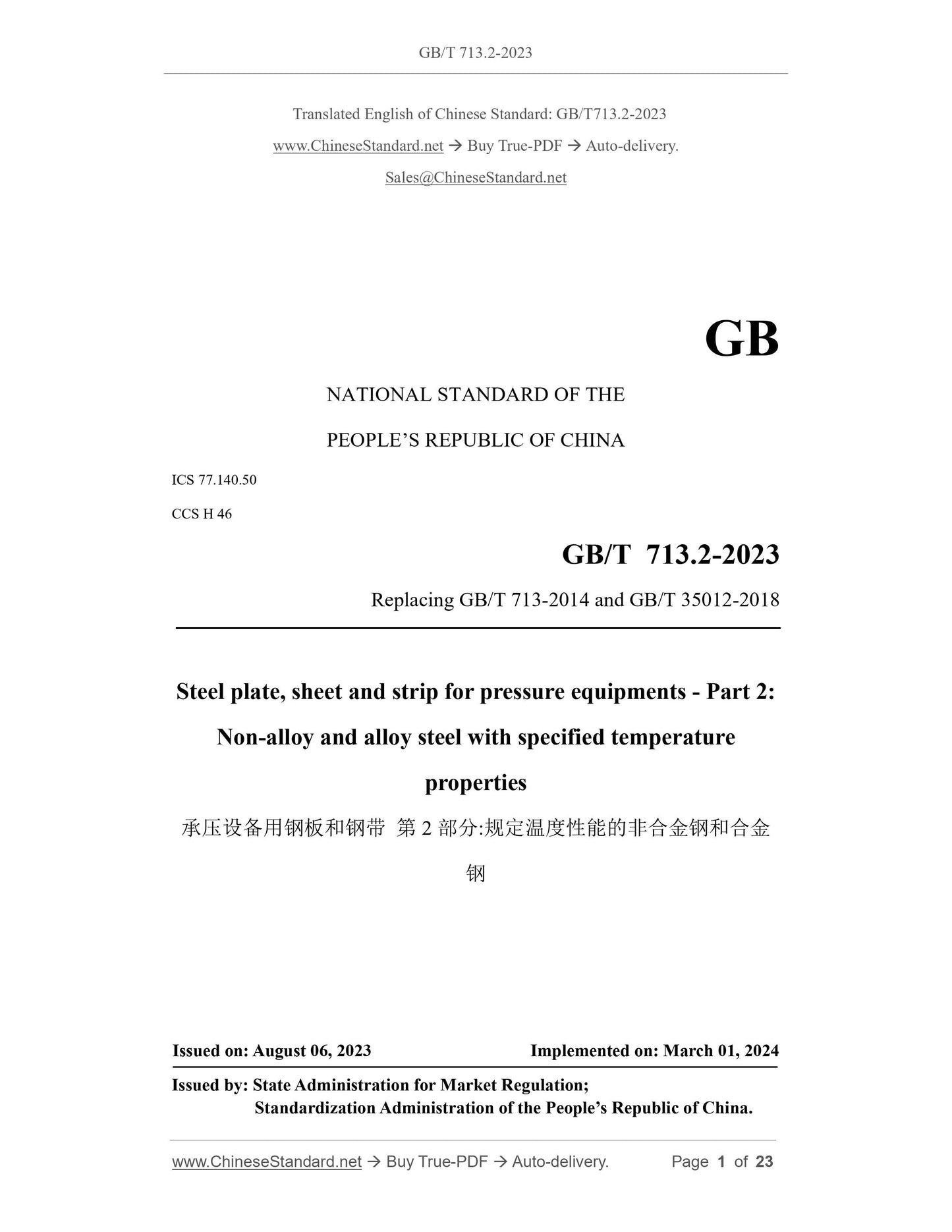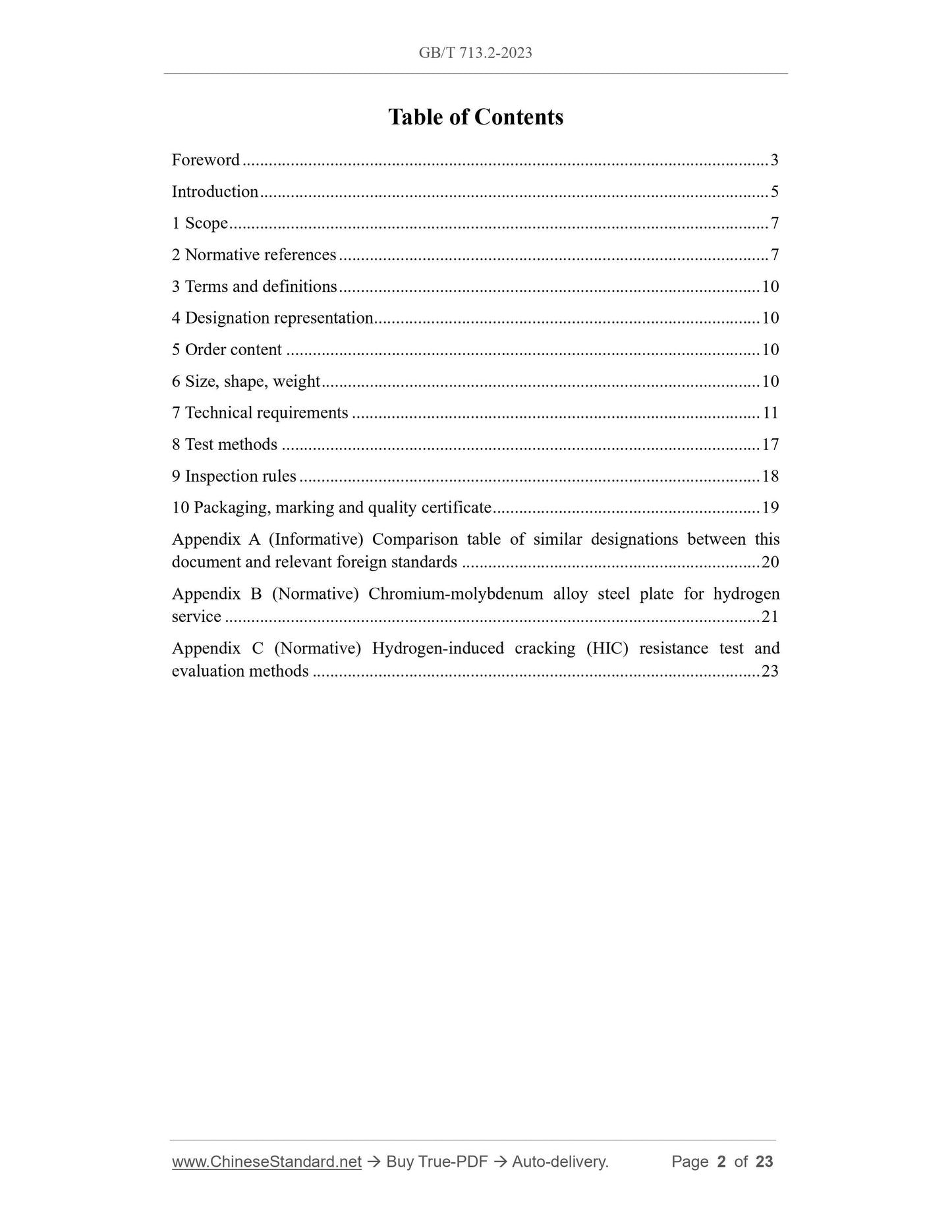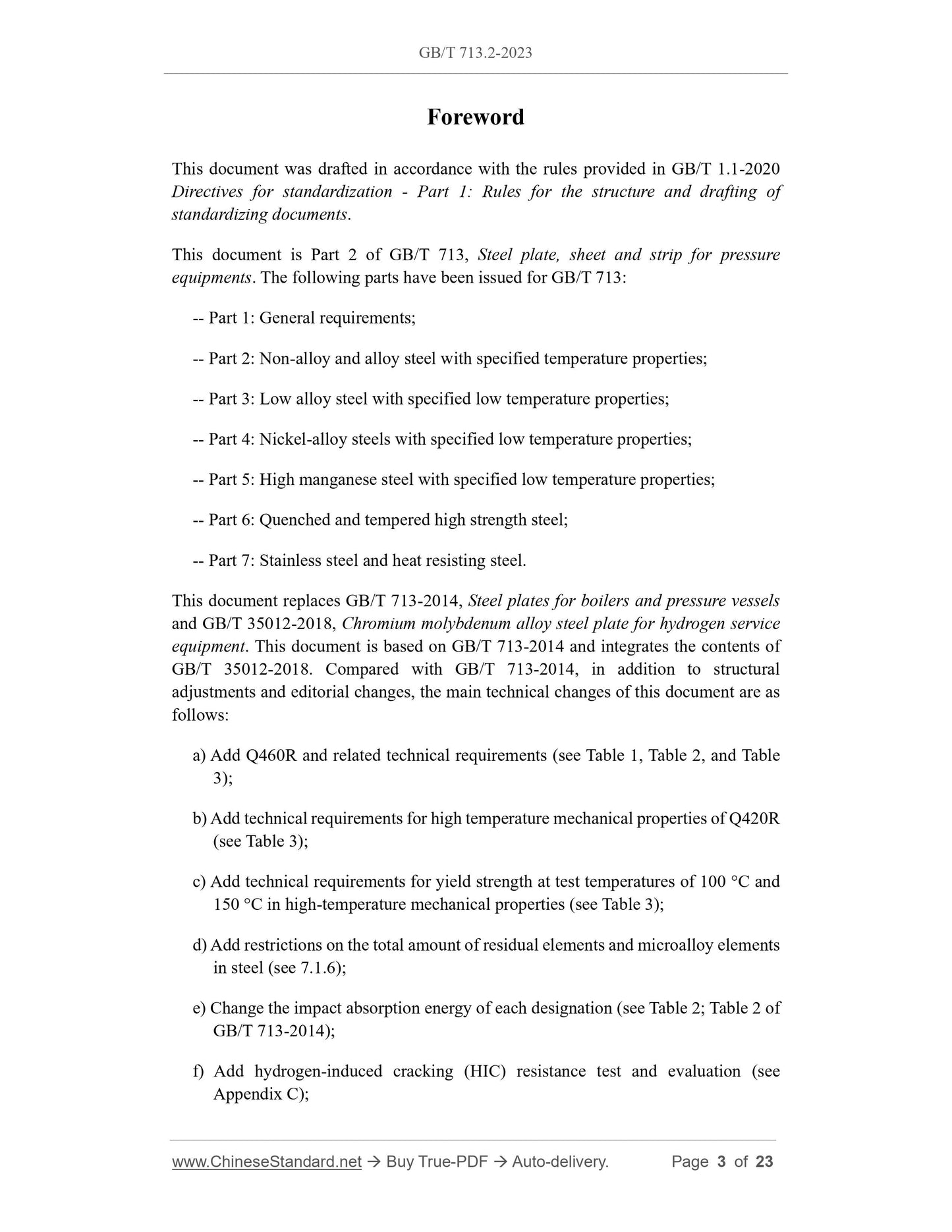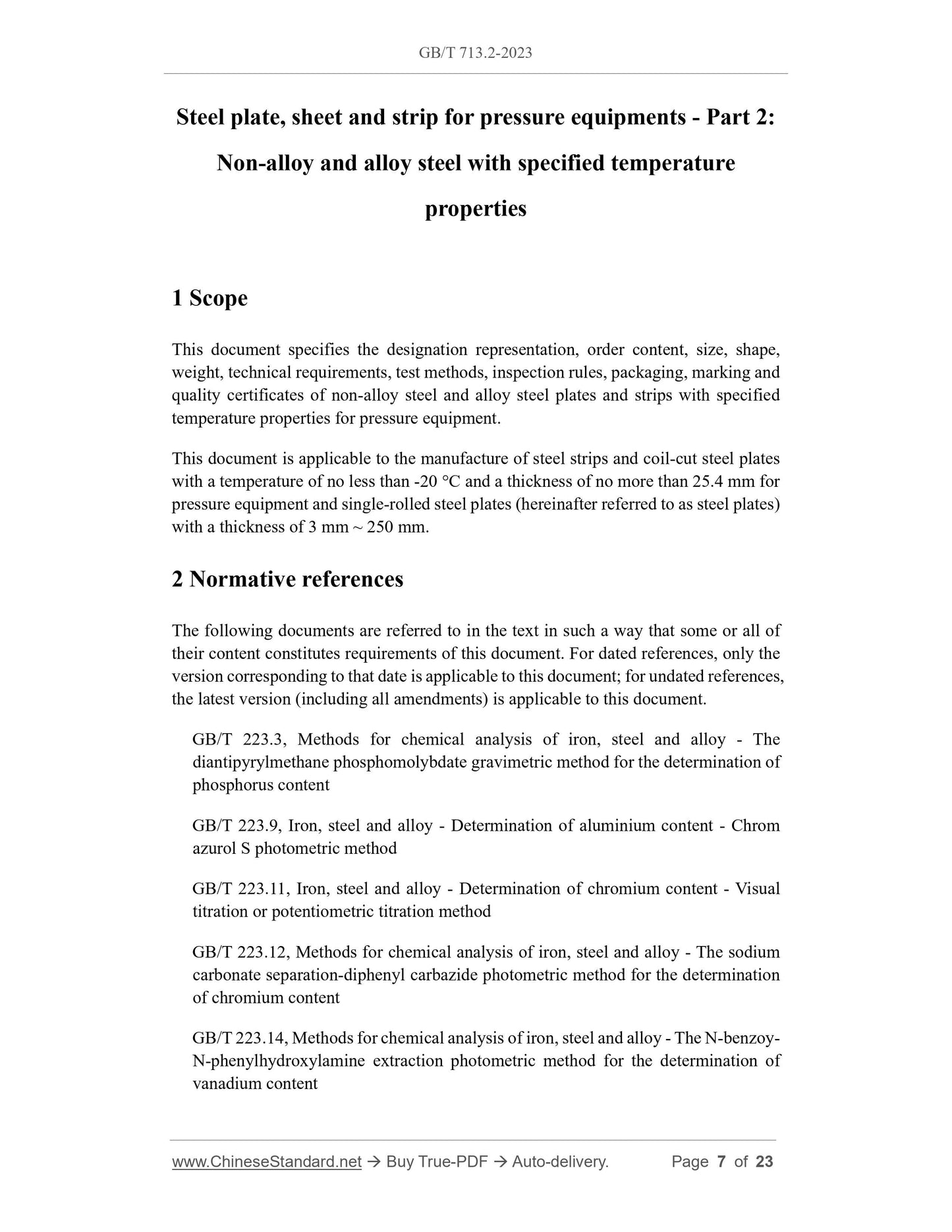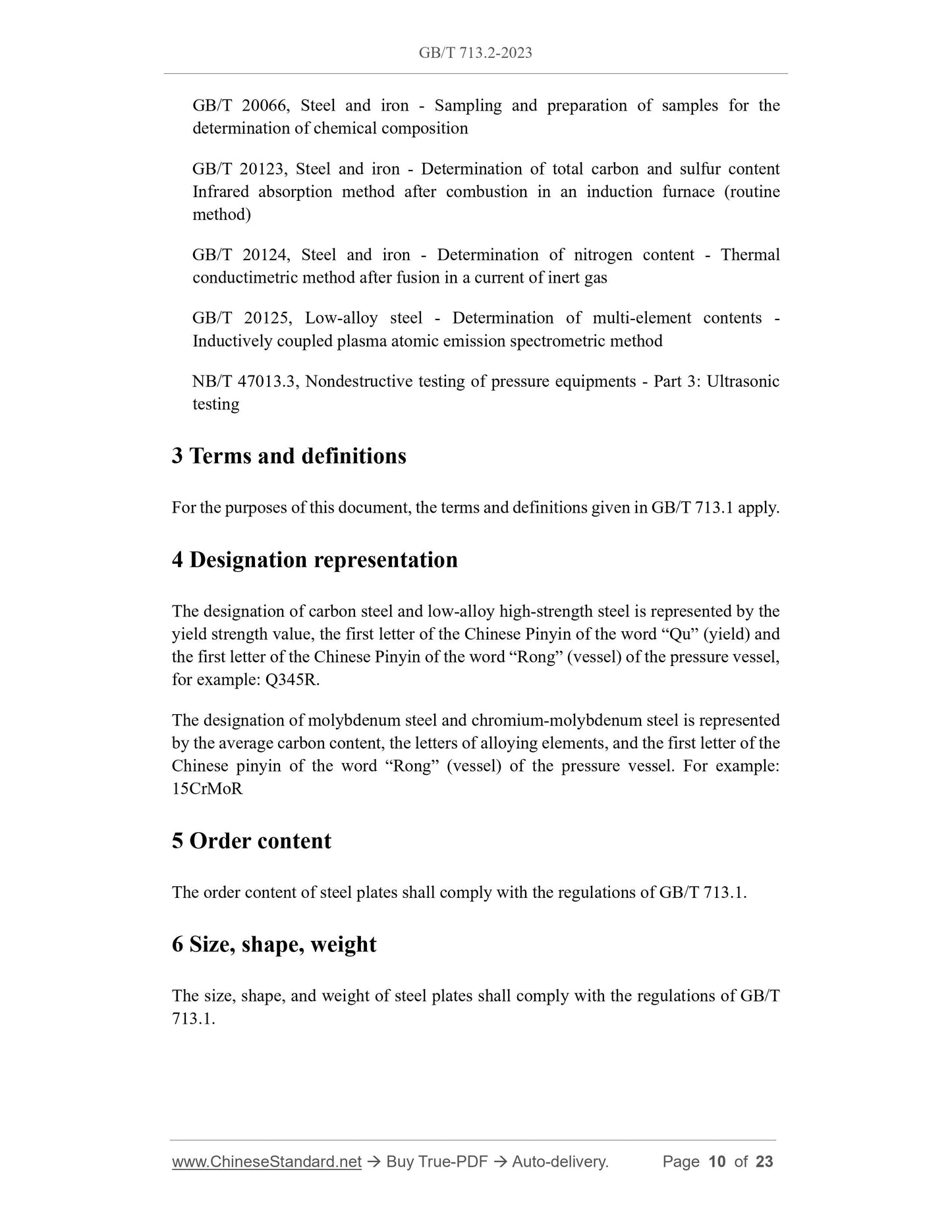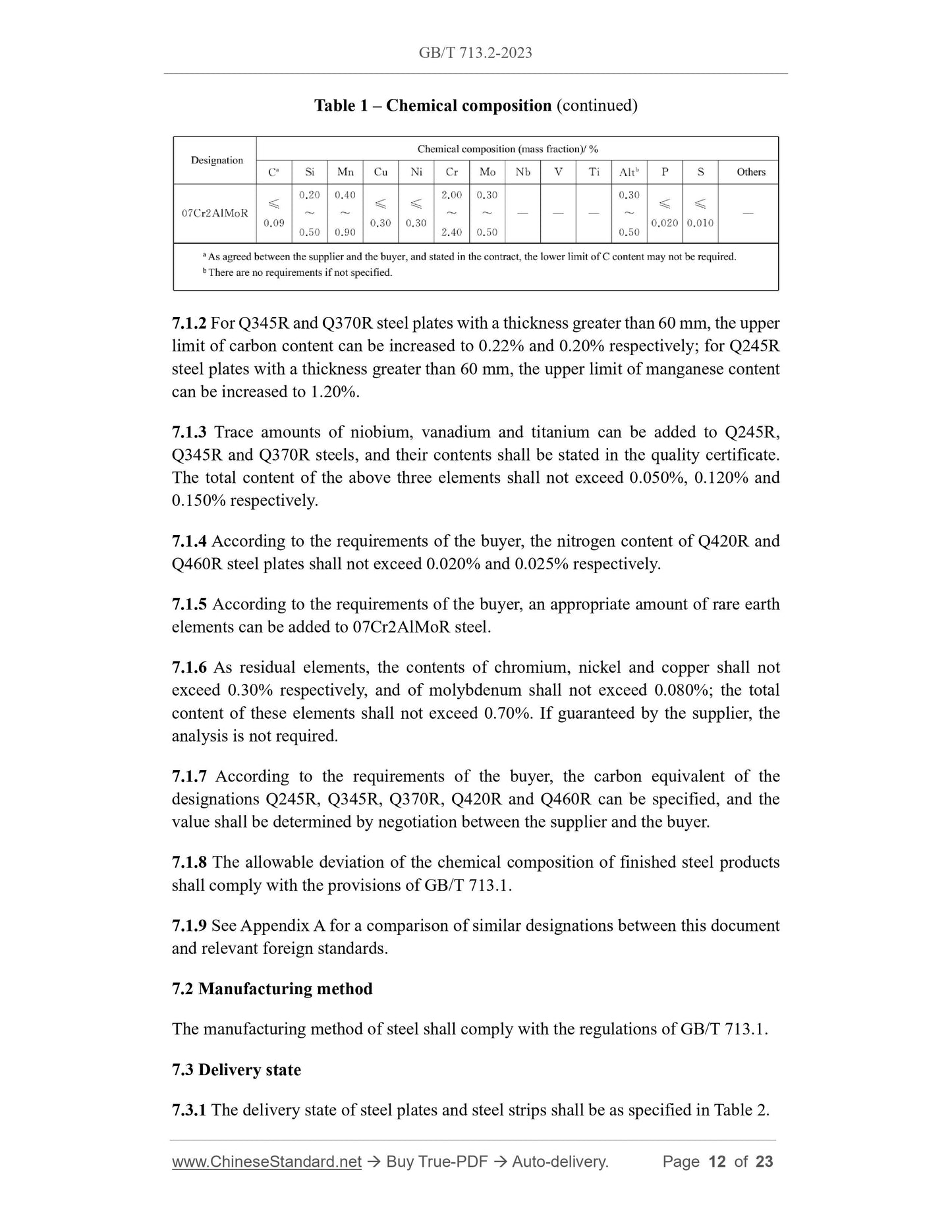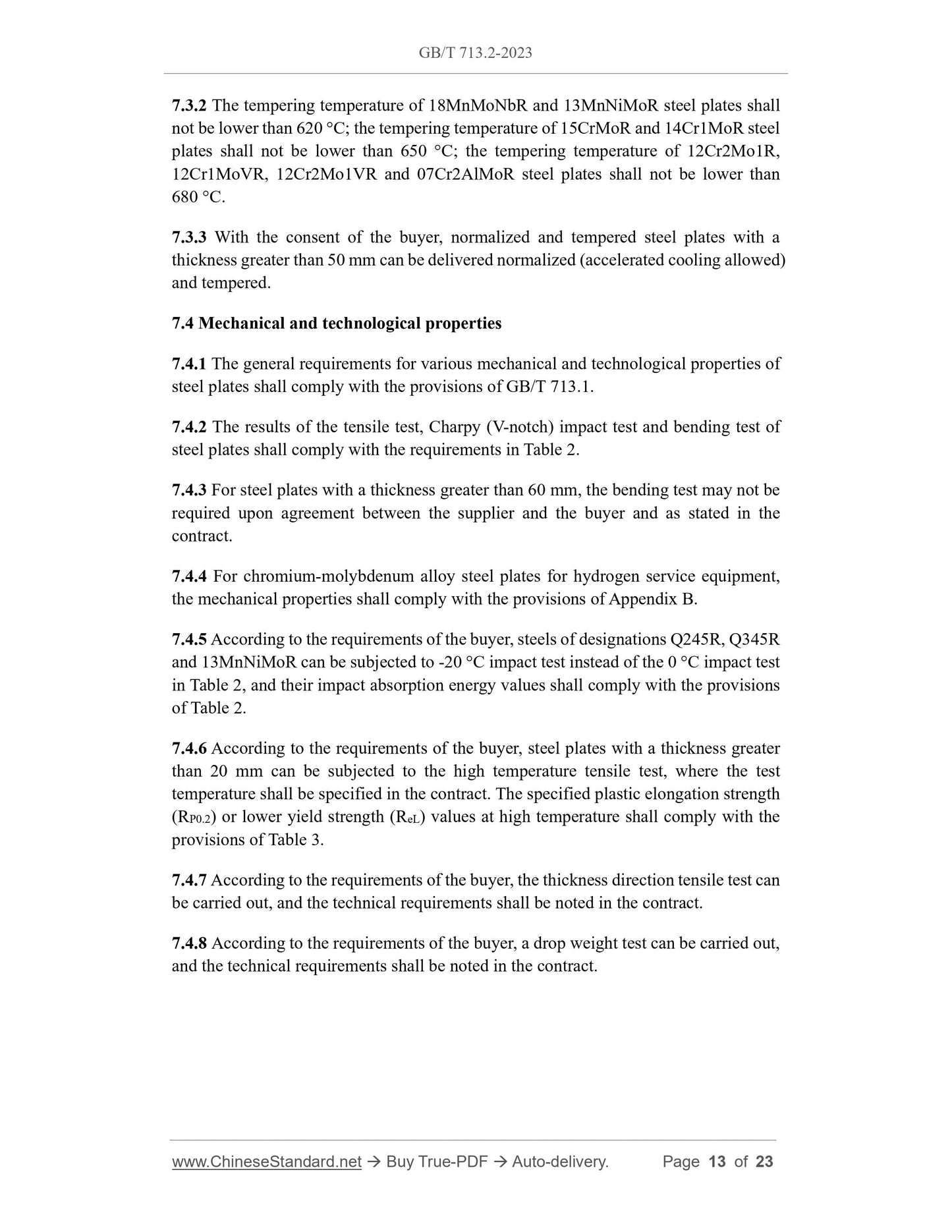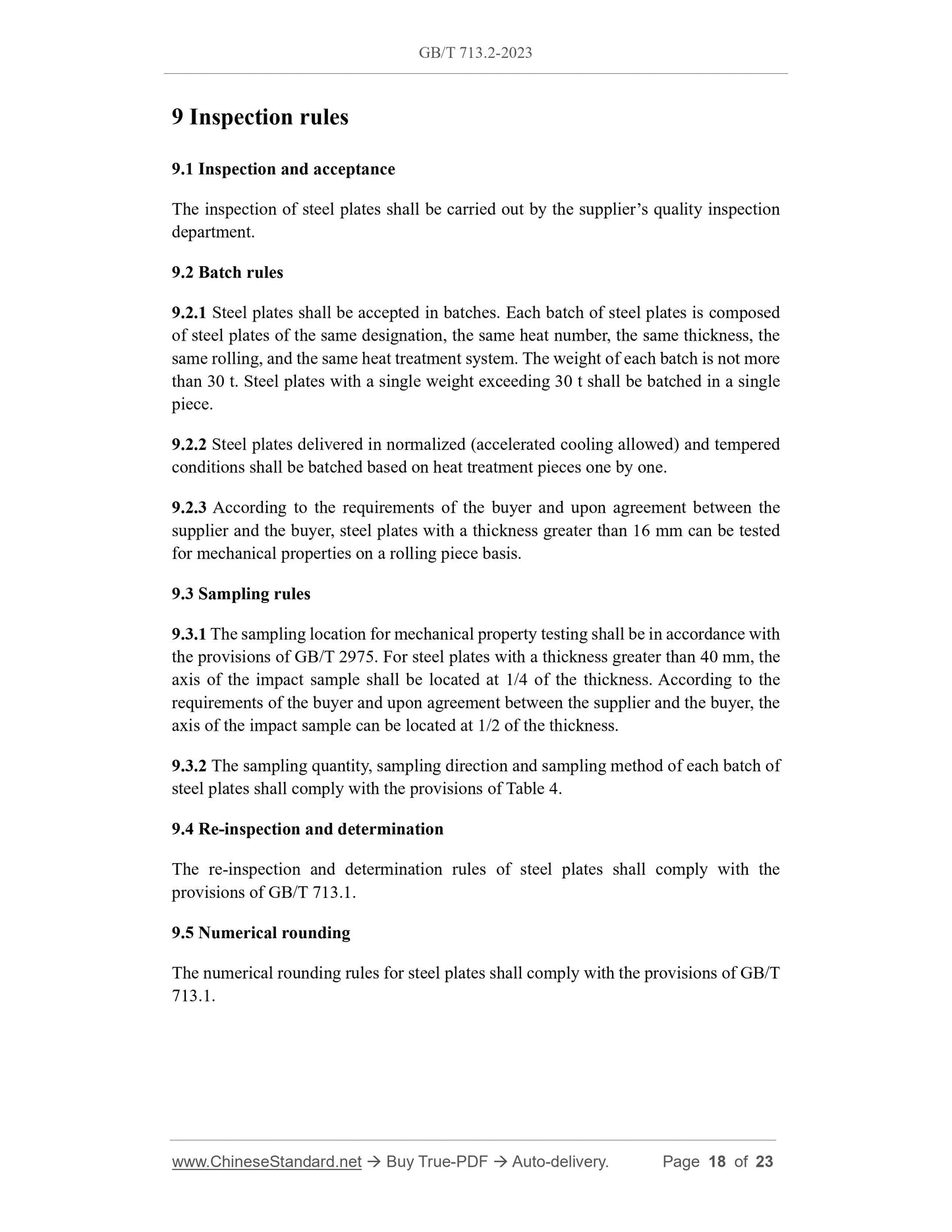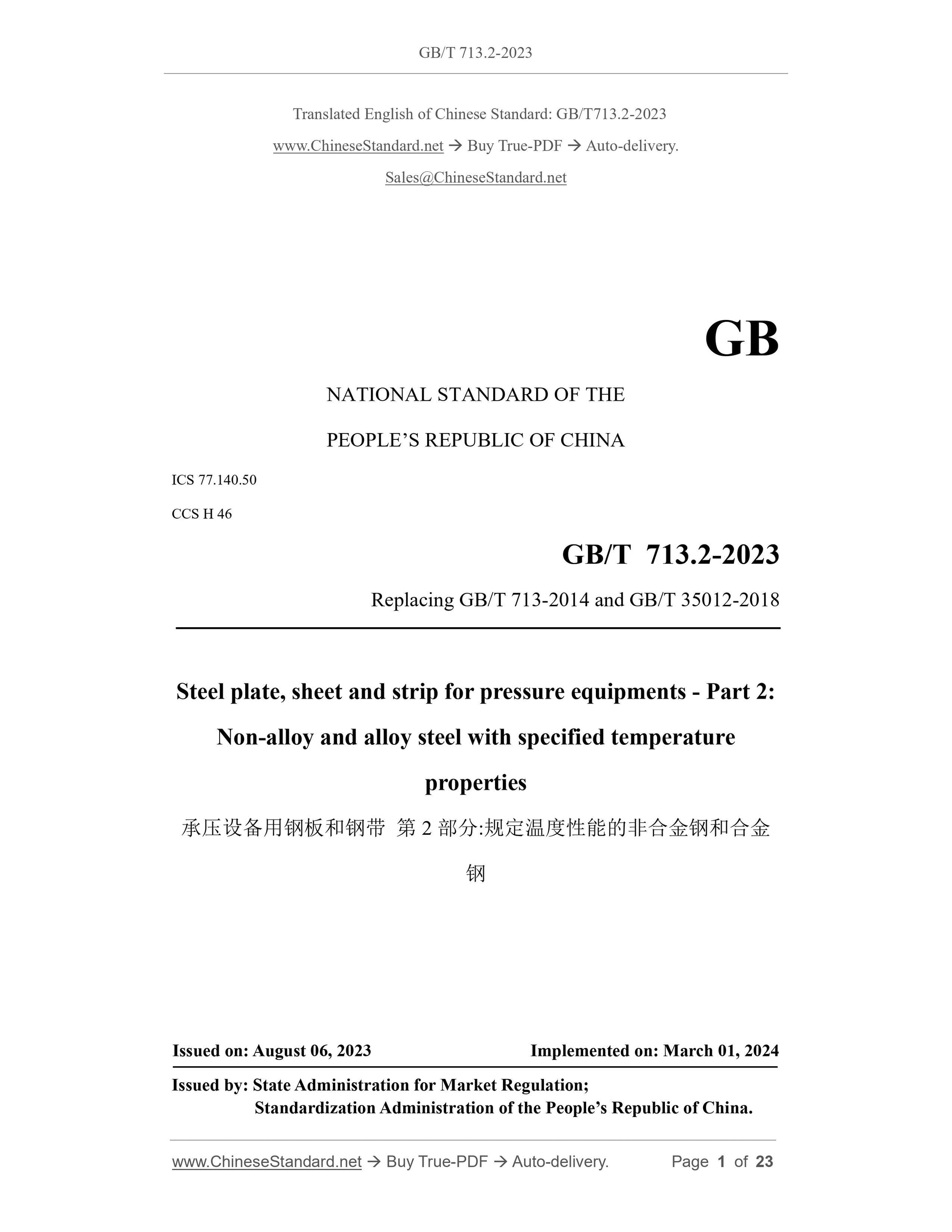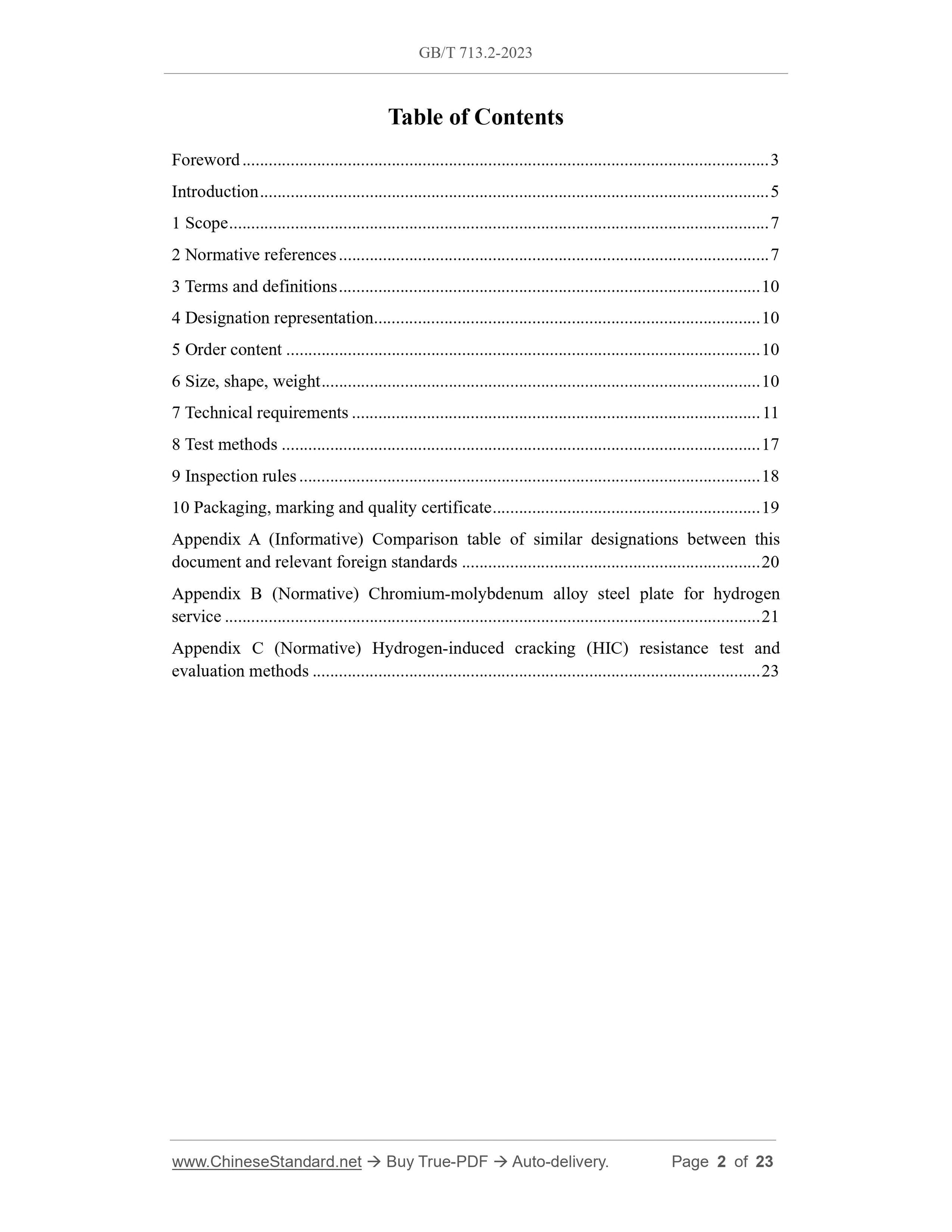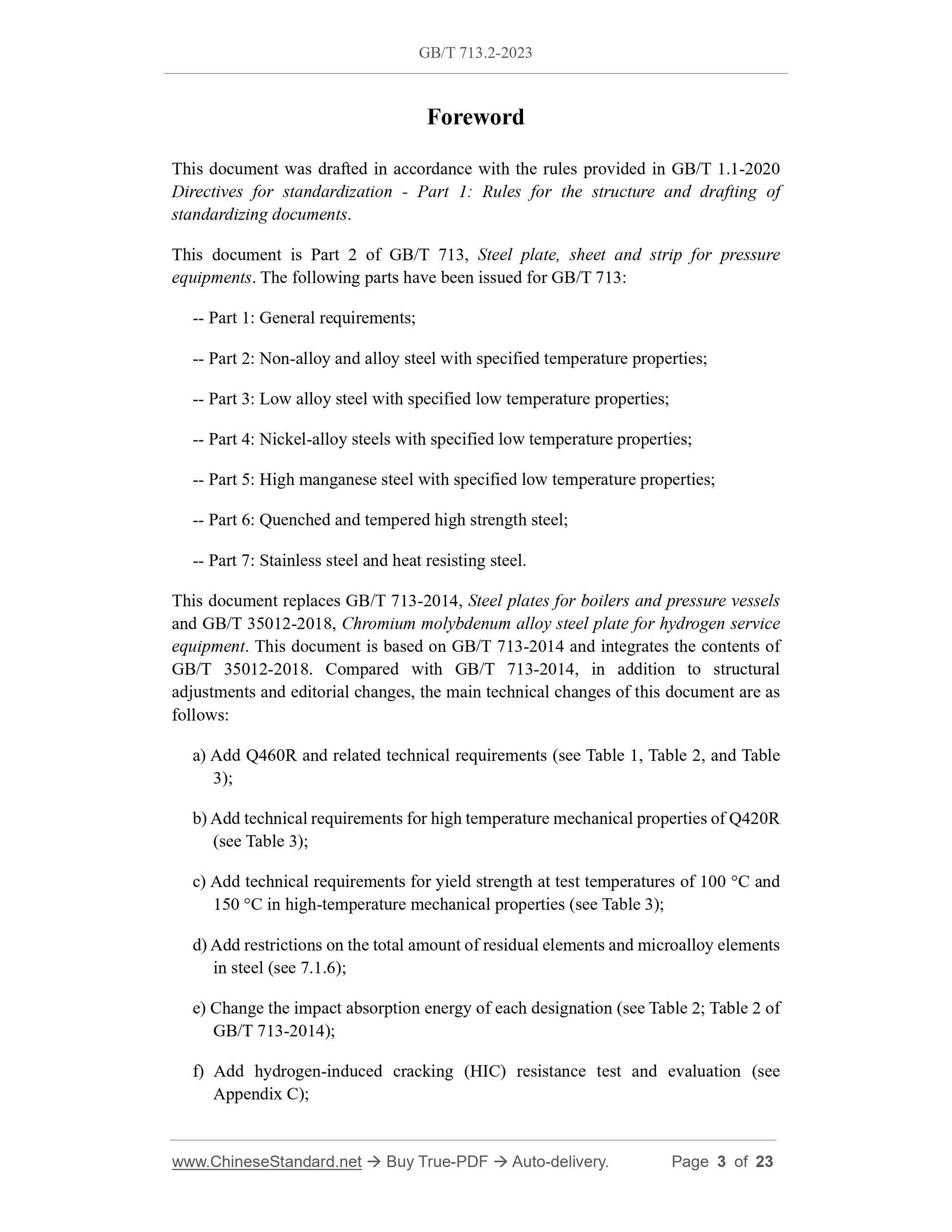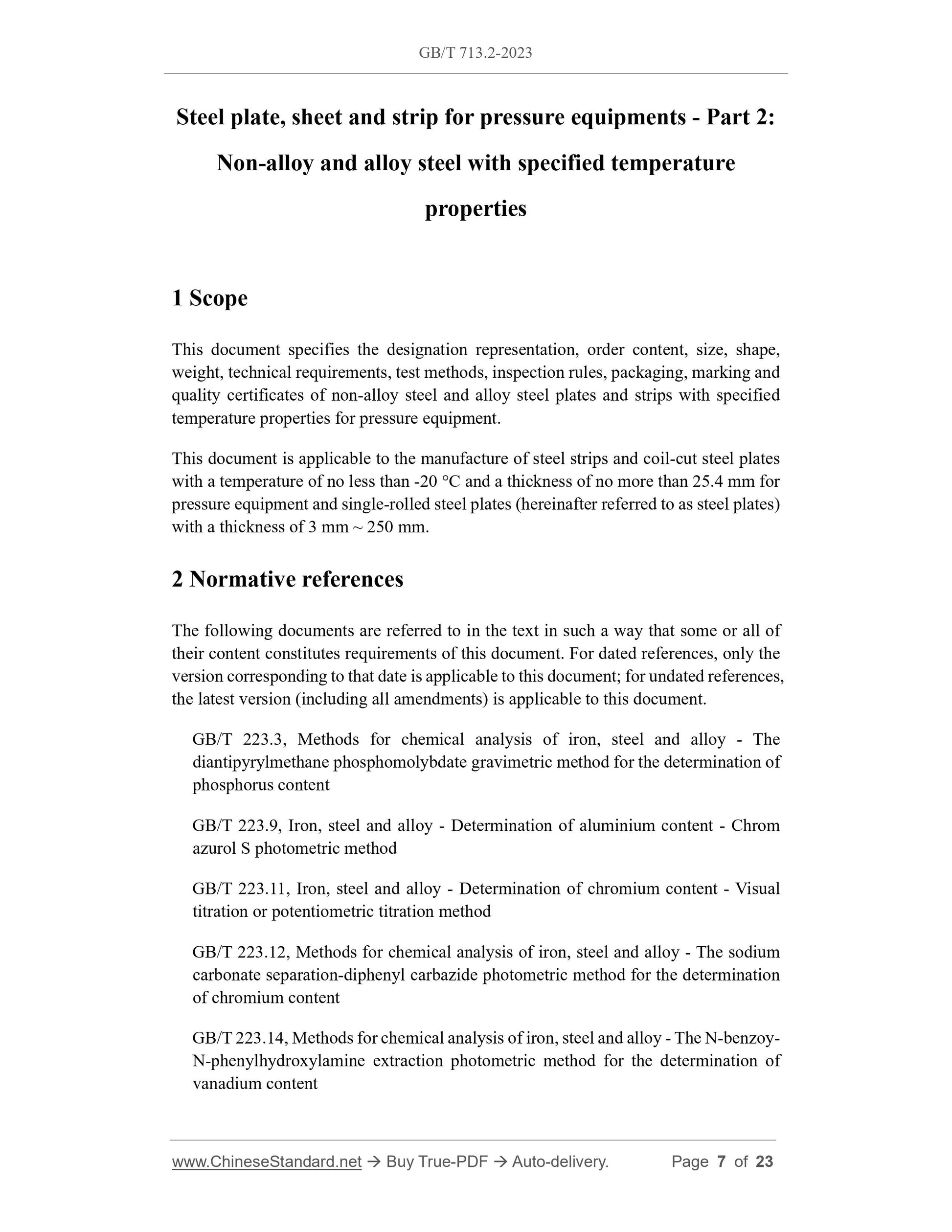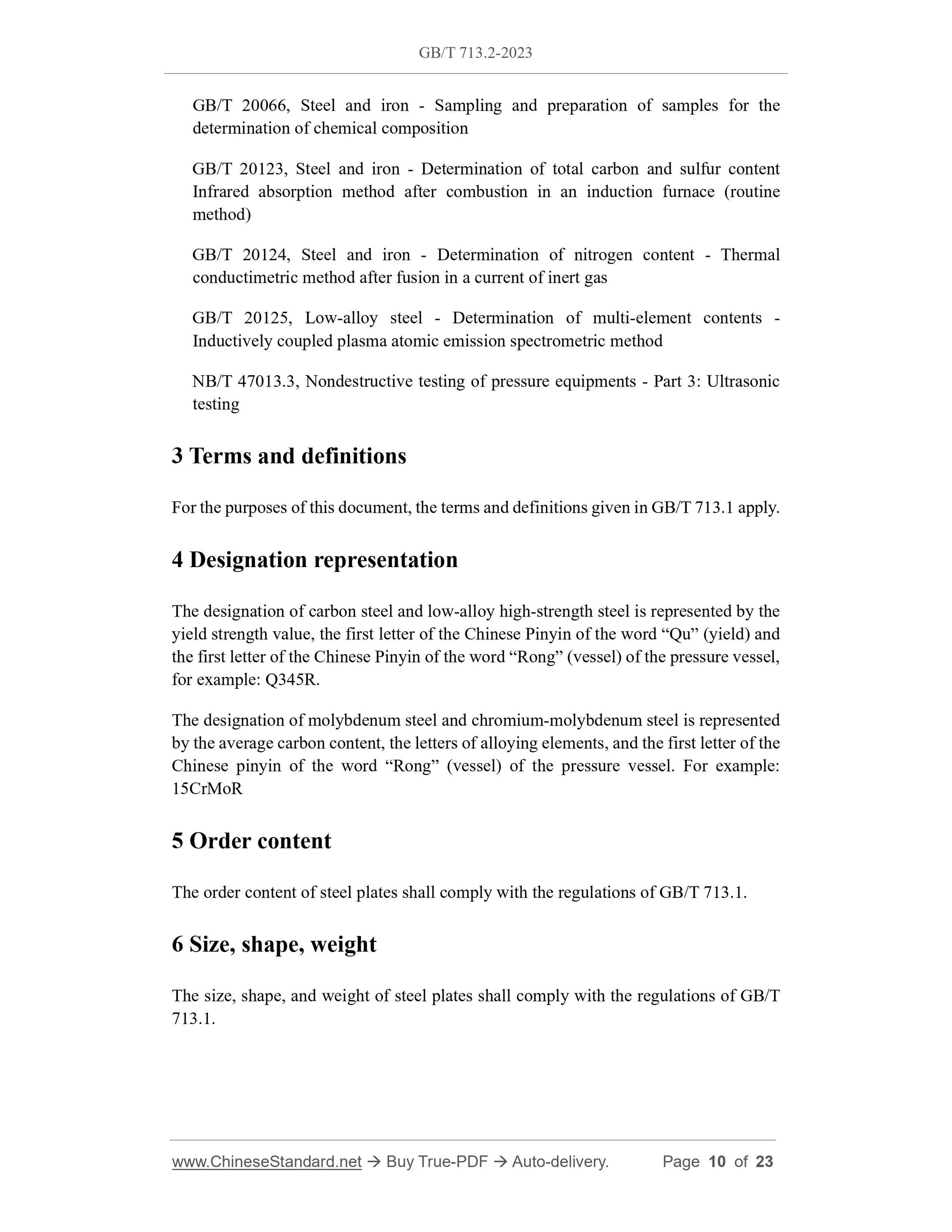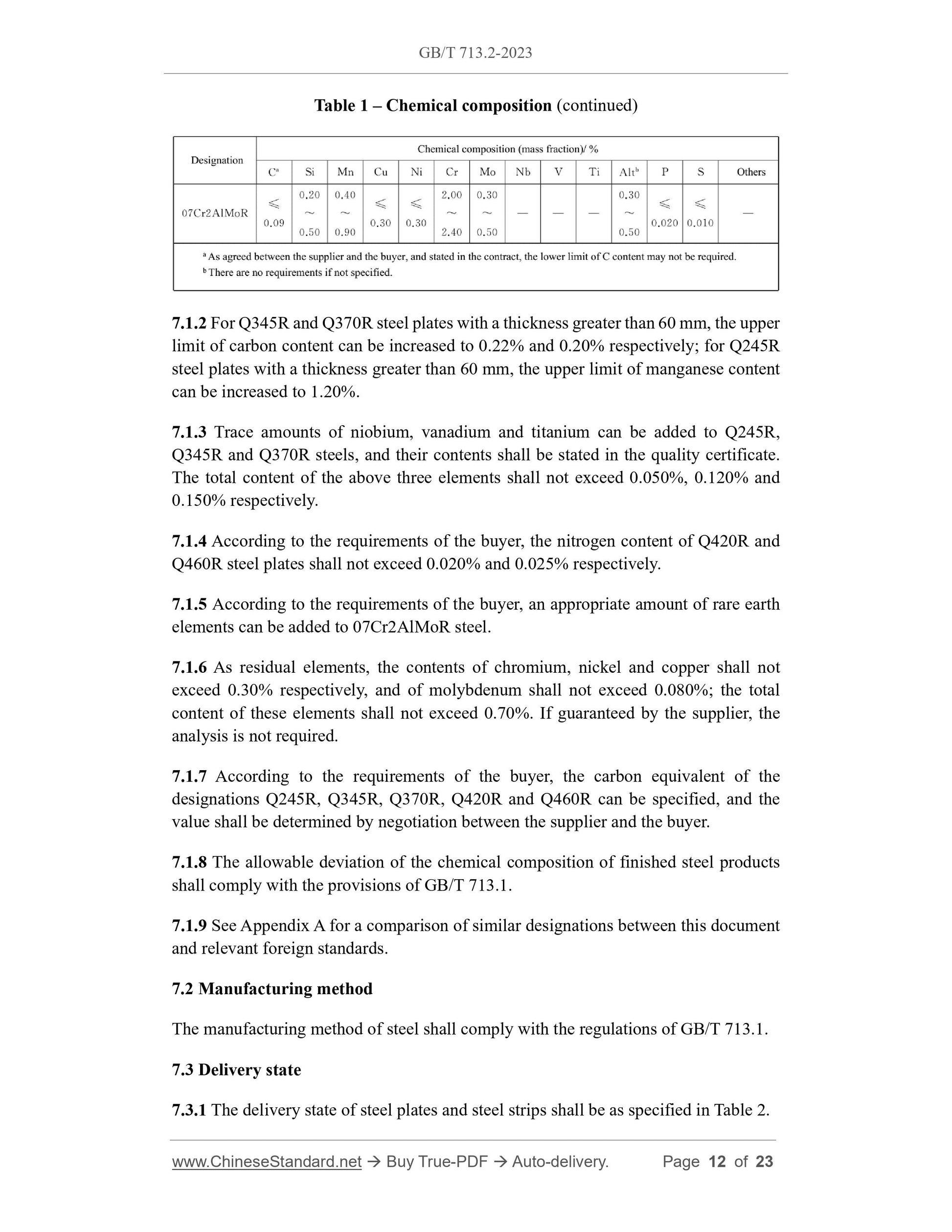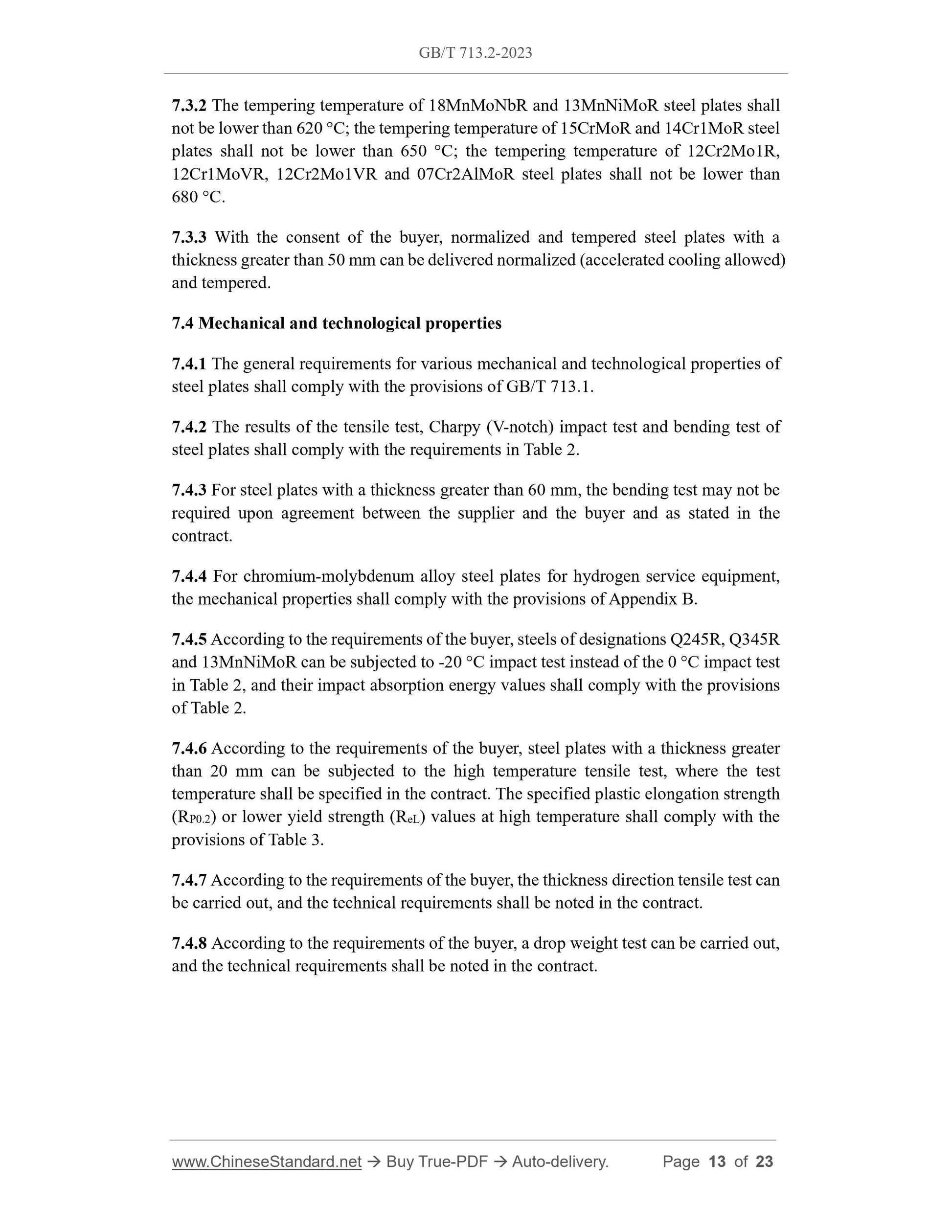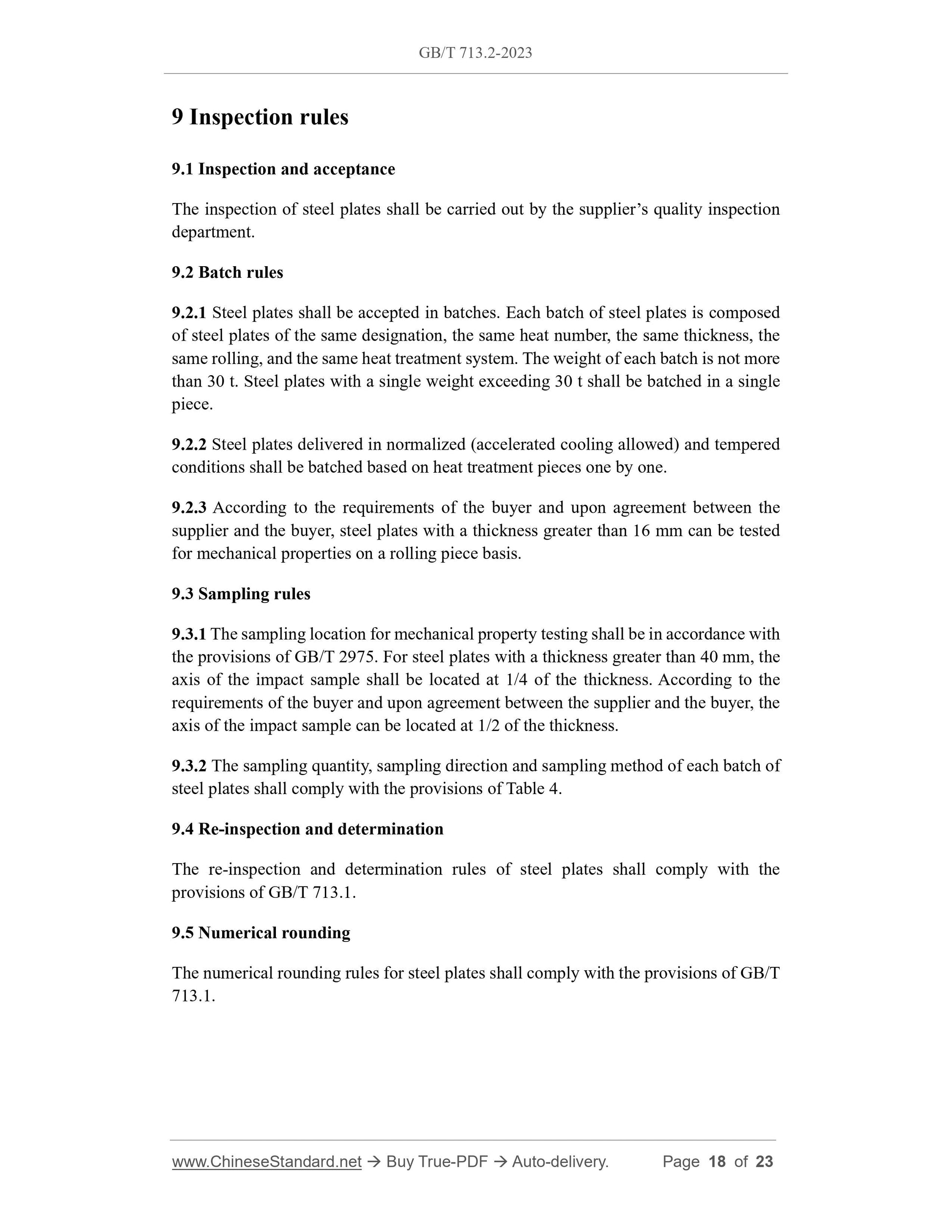PayPal, credit cards. Download editable-PDF and invoice in 1 second!
GB/T 713.2-2023 English PDF (GBT713.2-2023)
GB/T 713.2-2023 English PDF (GBT713.2-2023)
Precio habitual
$260.00 USD
Precio habitual
Precio de oferta
$260.00 USD
Precio unitario
/
por
Los gastos de envío se calculan en la pantalla de pago.
No se pudo cargar la disponibilidad de retiro
Delivery: 3 seconds. Download true-PDF + Invoice.
Get QUOTATION in 1-minute: Click GB/T 713.2-2023
Historical versions: GB/T 713.2-2023
Preview True-PDF (Reload/Scroll if blank)
GB/T 713.2-2023: Steel plate, sheet and strip for pressure equipments - Part 2: Non-alloy and alloy steel with specified temperature properties
GB/T 713.2-2023
GB
NATIONAL STANDARD OF THE
PEOPLE’S REPUBLIC OF CHINA
ICS 77.140.50
CCS H 46
Replacing GB/T 713-2014 and GB/T 35012-2018
Steel plate, sheet and strip for pressure equipments - Part 2:
Non-alloy and alloy steel with specified temperature
properties
ISSUED ON: AUGUST 06, 2023
IMPLEMENTED ON: MARCH 01, 2024
Issued by: State Administration for Market Regulation;
Standardization Administration of the People’s Republic of China.
Table of Contents
Foreword ... 3
Introduction ... 5
1 Scope ... 7
2 Normative references ... 7
3 Terms and definitions ... 10
4 Designation representation ... 10
5 Order content ... 10
6 Size, shape, weight ... 10
7 Technical requirements ... 11
8 Test methods ... 17
9 Inspection rules ... 18
10 Packaging, marking and quality certificate ... 19
Appendix A (Informative) Comparison table of similar designations between this
document and relevant foreign standards ... 20
Appendix B (Normative) Chromium-molybdenum alloy steel plate for hydrogen
service ... 21
Appendix C (Normative) Hydrogen-induced cracking (HIC) resistance test and
evaluation methods ... 23
Foreword
This document was drafted in accordance with the rules provided in GB/T 1.1-2020
Directives for standardization - Part 1: Rules for the structure and drafting of
standardizing documents.
This document is Part 2 of GB/T 713, Steel plate, sheet and strip for pressure
equipments. The following parts have been issued for GB/T 713:
-- Part 1: General requirements;
-- Part 2: Non-alloy and alloy steel with specified temperature properties;
-- Part 3: Low alloy steel with specified low temperature properties;
-- Part 4: Nickel-alloy steels with specified low temperature properties;
-- Part 5: High manganese steel with specified low temperature properties;
-- Part 6: Quenched and tempered high strength steel;
-- Part 7: Stainless steel and heat resisting steel.
This document replaces GB/T 713-2014, Steel plates for boilers and pressure vessels
and GB/T 35012-2018, Chromium molybdenum alloy steel plate for hydrogen service
equipment. This document is based on GB/T 713-2014 and integrates the contents of
GB/T 35012-2018. Compared with GB/T 713-2014, in addition to structural
adjustments and editorial changes, the main technical changes of this document are as
follows:
a) Add Q460R and related technical requirements (see Table 1, Table 2, and Table
3);
b) Add technical requirements for high temperature mechanical properties of Q420R
(see Table 3);
c) Add technical requirements for yield strength at test temperatures of 100 °C and
150 °C in high-temperature mechanical properties (see Table 3);
d) Add restrictions on the total amount of residual elements and microalloy elements
in steel (see 7.1.6);
e) Change the impact absorption energy of each designation (see Table 2; Table 2 of
GB/T 713-2014);
f) Add hydrogen-induced cracking (HIC) resistance test and evaluation (see
Appendix C);
Steel plate, sheet and strip for pressure equipments - Part 2:
Non-alloy and alloy steel with specified temperature
properties
1 Scope
This document specifies the designation representation, order content, size, shape,
weight, technical requirements, test methods, inspection rules, packaging, marking and
quality certificates of non-alloy steel and alloy steel plates and strips with specified
temperature properties for pressure equipment.
This document is applicable to the manufacture of steel strips and coil-cut steel plates
with a temperature of no less than -20 °C and a thickness of no more than 25.4 mm for
pressure equipment and single-rolled steel plates (hereinafter referred to as steel plates)
with a thickness of 3 mm ~ 250 mm.
2 Normative references
The following documents are referred to in the text in such a way that some or all of
their content constitutes requirements of this document. For dated references, only the
version corresponding to that date is applicable to this document; for undated references,
the latest version (including all amendments) is applicable to this document.
GB/T 223.3, Methods for chemical analysis of iron, steel and alloy - The
diantipyrylmethane phosphomolybdate gravimetric method for the determination of
phosphorus content
GB/T 223.9, Iron, steel and alloy - Determination of aluminium content - Chrom
azurol S photometric method
GB/T 223.11, Iron, steel and alloy - Determination of chromium content - Visual
titration or potentiometric titration method
GB/T 223.12, Methods for chemical analysis of iron, steel and alloy - The sodium
carbonate separation-diphenyl carbazide photometric method for the determination
of chromium content
GB/T 223.14, Methods for chemical analysis of iron, steel and alloy - The N-benzoy-
N-phenylhydroxylamine extraction photometric method for the determination of
vanadium content
GB/T 20066, Steel and iron - Sampling and preparation of samples for the
determination of chemical composition
GB/T 20123, Steel and iron - Determination of total carbon and sulfur content
Infrared absorption method after combustion in an induction furnace (routine
method)
GB/T 20124, Steel and iron - Determination of nitrogen content - Thermal
conductimetric method after fusion in a current of inert gas
GB/T 20125, Low-alloy steel - Determination of multi-element contents -
Inductively coupled plasma atomic emission spectrometric method
NB/T 47013.3, Nondestructive testing of pressure equipments - Part 3: Ultrasonic
testing
3 Terms and definitions
For the purposes of this document, the terms and definitions given in GB/T 713.1 apply.
4 Designation representation
The designation of carbon steel and low-alloy high-strength steel is represented by the
yield strength value, the first letter of the Chinese Pinyin of the word “Qu” (yield) and
the first letter of the Chinese Pinyin of the word “Rong” (vessel) of the pressure vessel,
for example: Q345R.
The designation of molybdenum steel and chromium-molybdenum steel is represented
by the average carbon content, the letters of alloying elements, and the first letter of the
Chinese pinyin of the word “Rong” (vessel) of the pressure vessel. For example:
15CrMoR
5 Order content
The order content of steel plates shall comply with the regulations of GB/T 713.1.
6 Size, shape, weight
The size, shape, and weight of steel plates shall comply with the regulations of GB/T
713.1.
Table 1 – Chemical composition (continued)
7.1.2 For Q345R and Q370R steel plates with a thickness greater than 60 mm, the upper
limit of carbon content can be increased to 0.22% and 0.20% respectively; for Q245R
steel plates with a thickness greater than 60 mm, the upper limit of manganese content
can be increased to 1.20%.
7.1.3 Trace amounts of niobium, vanadium and titanium can be added to Q245R,
Q345R and Q370R steels, and their contents shall be stated in the quality certificate.
The total content of the above three elements shall not exceed 0.050%, 0.120% and
0.150% respectively.
7.1.4 According to the requirements of the buyer, the nitrogen content of Q420R and
Q460R steel plates shall not exceed 0.020% and 0.025% respectively.
7.1.5 According to the requirements of the buyer, an appropriate amount of rare earth
elements can be added to 07Cr2AlMoR steel.
7.1.6 As residual elements, the contents of chromium, nickel and copper shall not
exceed 0.30% respectively, and of mol...
Get QUOTATION in 1-minute: Click GB/T 713.2-2023
Historical versions: GB/T 713.2-2023
Preview True-PDF (Reload/Scroll if blank)
GB/T 713.2-2023: Steel plate, sheet and strip for pressure equipments - Part 2: Non-alloy and alloy steel with specified temperature properties
GB/T 713.2-2023
GB
NATIONAL STANDARD OF THE
PEOPLE’S REPUBLIC OF CHINA
ICS 77.140.50
CCS H 46
Replacing GB/T 713-2014 and GB/T 35012-2018
Steel plate, sheet and strip for pressure equipments - Part 2:
Non-alloy and alloy steel with specified temperature
properties
ISSUED ON: AUGUST 06, 2023
IMPLEMENTED ON: MARCH 01, 2024
Issued by: State Administration for Market Regulation;
Standardization Administration of the People’s Republic of China.
Table of Contents
Foreword ... 3
Introduction ... 5
1 Scope ... 7
2 Normative references ... 7
3 Terms and definitions ... 10
4 Designation representation ... 10
5 Order content ... 10
6 Size, shape, weight ... 10
7 Technical requirements ... 11
8 Test methods ... 17
9 Inspection rules ... 18
10 Packaging, marking and quality certificate ... 19
Appendix A (Informative) Comparison table of similar designations between this
document and relevant foreign standards ... 20
Appendix B (Normative) Chromium-molybdenum alloy steel plate for hydrogen
service ... 21
Appendix C (Normative) Hydrogen-induced cracking (HIC) resistance test and
evaluation methods ... 23
Foreword
This document was drafted in accordance with the rules provided in GB/T 1.1-2020
Directives for standardization - Part 1: Rules for the structure and drafting of
standardizing documents.
This document is Part 2 of GB/T 713, Steel plate, sheet and strip for pressure
equipments. The following parts have been issued for GB/T 713:
-- Part 1: General requirements;
-- Part 2: Non-alloy and alloy steel with specified temperature properties;
-- Part 3: Low alloy steel with specified low temperature properties;
-- Part 4: Nickel-alloy steels with specified low temperature properties;
-- Part 5: High manganese steel with specified low temperature properties;
-- Part 6: Quenched and tempered high strength steel;
-- Part 7: Stainless steel and heat resisting steel.
This document replaces GB/T 713-2014, Steel plates for boilers and pressure vessels
and GB/T 35012-2018, Chromium molybdenum alloy steel plate for hydrogen service
equipment. This document is based on GB/T 713-2014 and integrates the contents of
GB/T 35012-2018. Compared with GB/T 713-2014, in addition to structural
adjustments and editorial changes, the main technical changes of this document are as
follows:
a) Add Q460R and related technical requirements (see Table 1, Table 2, and Table
3);
b) Add technical requirements for high temperature mechanical properties of Q420R
(see Table 3);
c) Add technical requirements for yield strength at test temperatures of 100 °C and
150 °C in high-temperature mechanical properties (see Table 3);
d) Add restrictions on the total amount of residual elements and microalloy elements
in steel (see 7.1.6);
e) Change the impact absorption energy of each designation (see Table 2; Table 2 of
GB/T 713-2014);
f) Add hydrogen-induced cracking (HIC) resistance test and evaluation (see
Appendix C);
Steel plate, sheet and strip for pressure equipments - Part 2:
Non-alloy and alloy steel with specified temperature
properties
1 Scope
This document specifies the designation representation, order content, size, shape,
weight, technical requirements, test methods, inspection rules, packaging, marking and
quality certificates of non-alloy steel and alloy steel plates and strips with specified
temperature properties for pressure equipment.
This document is applicable to the manufacture of steel strips and coil-cut steel plates
with a temperature of no less than -20 °C and a thickness of no more than 25.4 mm for
pressure equipment and single-rolled steel plates (hereinafter referred to as steel plates)
with a thickness of 3 mm ~ 250 mm.
2 Normative references
The following documents are referred to in the text in such a way that some or all of
their content constitutes requirements of this document. For dated references, only the
version corresponding to that date is applicable to this document; for undated references,
the latest version (including all amendments) is applicable to this document.
GB/T 223.3, Methods for chemical analysis of iron, steel and alloy - The
diantipyrylmethane phosphomolybdate gravimetric method for the determination of
phosphorus content
GB/T 223.9, Iron, steel and alloy - Determination of aluminium content - Chrom
azurol S photometric method
GB/T 223.11, Iron, steel and alloy - Determination of chromium content - Visual
titration or potentiometric titration method
GB/T 223.12, Methods for chemical analysis of iron, steel and alloy - The sodium
carbonate separation-diphenyl carbazide photometric method for the determination
of chromium content
GB/T 223.14, Methods for chemical analysis of iron, steel and alloy - The N-benzoy-
N-phenylhydroxylamine extraction photometric method for the determination of
vanadium content
GB/T 20066, Steel and iron - Sampling and preparation of samples for the
determination of chemical composition
GB/T 20123, Steel and iron - Determination of total carbon and sulfur content
Infrared absorption method after combustion in an induction furnace (routine
method)
GB/T 20124, Steel and iron - Determination of nitrogen content - Thermal
conductimetric method after fusion in a current of inert gas
GB/T 20125, Low-alloy steel - Determination of multi-element contents -
Inductively coupled plasma atomic emission spectrometric method
NB/T 47013.3, Nondestructive testing of pressure equipments - Part 3: Ultrasonic
testing
3 Terms and definitions
For the purposes of this document, the terms and definitions given in GB/T 713.1 apply.
4 Designation representation
The designation of carbon steel and low-alloy high-strength steel is represented by the
yield strength value, the first letter of the Chinese Pinyin of the word “Qu” (yield) and
the first letter of the Chinese Pinyin of the word “Rong” (vessel) of the pressure vessel,
for example: Q345R.
The designation of molybdenum steel and chromium-molybdenum steel is represented
by the average carbon content, the letters of alloying elements, and the first letter of the
Chinese pinyin of the word “Rong” (vessel) of the pressure vessel. For example:
15CrMoR
5 Order content
The order content of steel plates shall comply with the regulations of GB/T 713.1.
6 Size, shape, weight
The size, shape, and weight of steel plates shall comply with the regulations of GB/T
713.1.
Table 1 – Chemical composition (continued)
7.1.2 For Q345R and Q370R steel plates with a thickness greater than 60 mm, the upper
limit of carbon content can be increased to 0.22% and 0.20% respectively; for Q245R
steel plates with a thickness greater than 60 mm, the upper limit of manganese content
can be increased to 1.20%.
7.1.3 Trace amounts of niobium, vanadium and titanium can be added to Q245R,
Q345R and Q370R steels, and their contents shall be stated in the quality certificate.
The total content of the above three elements shall not exceed 0.050%, 0.120% and
0.150% respectively.
7.1.4 According to the requirements of the buyer, the nitrogen content of Q420R and
Q460R steel plates shall not exceed 0.020% and 0.025% respectively.
7.1.5 According to the requirements of the buyer, an appropriate amount of rare earth
elements can be added to 07Cr2AlMoR steel.
7.1.6 As residual elements, the contents of chromium, nickel and copper shall not
exceed 0.30% respectively, and of mol...
Share
